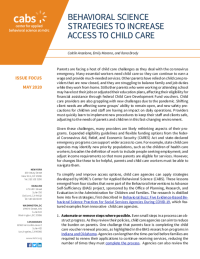Behavioral Science Strategies to Increase Access to Child Care

Parents are facing a host of child care challenges as they deal with the coronavirus emergency. Many essential workers need child care so they can continue to earn a wage and provide much-needed services. Other parents have relied on child care providers that are now closed, and they are struggling to balance family and job duties while they work from home. Still other parents who were working or attending school may have lost their jobs or adjusted their education plans, affecting their eligibility for financial assistance through federal Child Care Development Fund vouchers. Child care providers are also grappling with new challenges due to the pandemic. Shifting client needs are affecting some groups’ ability to remain open, and new safety precautions for children and staff are having an impact on daily operations. Providers must quickly learn to implement new procedures to keep their staff and clients safe, adjusting to the needs of parents and children in this fast-changing environment.
Given these challenges, many providers are likely rethinking aspects of their programs. Expanded eligibility guidelines and flexible funding options from the federal Coronavirus Aid, Relief, and Economic Security (CARES) Act and state-declared emergency programs can support wider access to care. For example, state child care agencies may identify new priority populations, such as the children of health care workers; broaden the definition of work to include people seeking employment; and adjust income requirements so that more parents are eligible for services. However, for changes like these to be helpful, parents and child care workers must be able to navigate them.
To simplify and improve access options, child care agencies can apply strategies developed by MDRC’s Center for Applied Behavioral Science (CABS). These lessons emerged from four studies that were part of the Behavioral Interventions to Advance Self-Sufficiency (BIAS) project, sponsored by the Office of Planning, Research, and Evaluation in the Administration for Children and Families. The research is distilled here into five strategies, first described in Behavioral Buzz: Five Evidence-Based Behavioral Science Practices for Social Services Agencies During COVID-19, which featured examples from innovative child care agencies.
- Automate or remove steps where possible. Even small steps in a process can obstruct progress. As they review their policies, child care agencies can aim to reduce the burden on parents. One challenge that parents face is completing the child care voucher renewal process, as highlighted in the BIAS research on programs in Indiana and Oklahoma. Agencies can lengthen the time-period before families are required to renew their applications to continue receiving services, reducing the number of times they must complete the process. Agencies can also review the renewal steps and forms and consider ways to simplify them. These changes would improve parents’ ability to navigate the process while minimizing staff time spent on renewals during this time of increased need.
- Limit options to those most relevant to the decision-maker. Having too many options can lead to inaction, a concept known as choice overload.[1] To avoid this fatigue, agencies can simplify their outreach to eligible families. In Indiana, parents who needed to select a child care provider in order to obtain a voucher were mailed a list of the three highest-quality providers in their area, based on their home address. Some parents also received a phone call from a child care staff member who explained the quality rating program and provided additional referrals. The mailing and the phone call together increased the likelihood that families would choose a highly rated provider. Providing parents with fewer, customized options and assistance can support the decision-making processes and encourage follow-through.
- Simplify communications by focusing on the action (what), motivation (why), steps (how), and deadline (when). It can be difficult for staff and clients to sift through complex and conflicting information at any time, but the pandemic has brought added stress and uncertainty. Child care agencies can use behavioral insights to make their communications clear and concise and reduce barriers to services. Indiana used behavioral insights to simplify the materials sent to parents who needed to renew their vouchers — emphasizing clear action steps, highlighting the renewal appointment date on the outreach letter, and adding a reminder. The new outreach increased attendance at recertification appointments, suggesting that simplified communications can better motivate action. Agencies can use this Effective Communications Checklist developed by CABS to review communications sent to parents.
- Break down actions into small, concrete steps. Another way to simplify communications is to break down processes into small, digestible steps. For example, Oklahoma used checklists of small steps to simplify the process and improve on-time renewals of child care subsidies. During staff-parent interactions at child care facilities, when the benefits of the subsidies were most salient to parents, staff members used the check lists to encourage clients to submit their renewal paperwork. Giving staff the right tools to clarify concrete steps for parents helped increase the on-time renewal rate, increasing access to benefits and reducing staff burden. Providers may consider applying these lessons to coronavirus-related communications such as rule changes about parent drop-offs and pick-ups, or center reopening timelines.
- Send actionable reminders. Reminders that provide clear actions toward key milestones can foster clarity, focusing the attention of staff and clients on the most pressing needs. For example, Indiana improved attendance at renewal appointments by sending clients reminder postcards two weeks in advance, outlining the essential steps to renew and emphasizing the deadline.
Rapidly changing policies and practices and expanded eligibility make this a critical time for child care agencies to help deliver essential services. As families face stress and emotional hardship from the health crisis, providers can use these evidence-based behavioral strategies to improve access to child care and help those in need.
Helpful Resources
For additional information or help implementing these communication strategies, contact Caitlin Anzelone at Caitlin.Anzelone@mdrc.org. Helpful resources and relevant publications are listed and linked.
- Behavioral Interventions to Advance Self-Sufficiency (BIAS) Materials Compendium
- Behavioral Buzz: Five Evidence-Based Behavioral Science Practices for Social Services Agencies During COVID-19
- Cutting Through Complexity: Using Behavioral Science to Improve Indiana’s Child Care Subsidy Program
- Engaging Providers and Clients: Using Behavioral Economics to Increase On-Time Child Care Subsidy Renewals
- Getting Your Message Across with the Effective Communications Checklist
Acknowledgements
MDRC would like to thank the Office of Planning, Research, and Evaluation in the Administration for Children and Families in the U.S. Department of Health and Human Services for sponsoring the BIAS project. We would also like to thank the administrators and staff at agencies in Indiana and Oklahoma for their partnership and support with these studies, and our research team.
[1]Iyengar, Sheena, and Mark Lepper (2000). “When Choice is Demotivating: Can One Desire Too Much of a Good Thing?” Journal of Personality and Social Psychology, 79(6), 995-1006.






